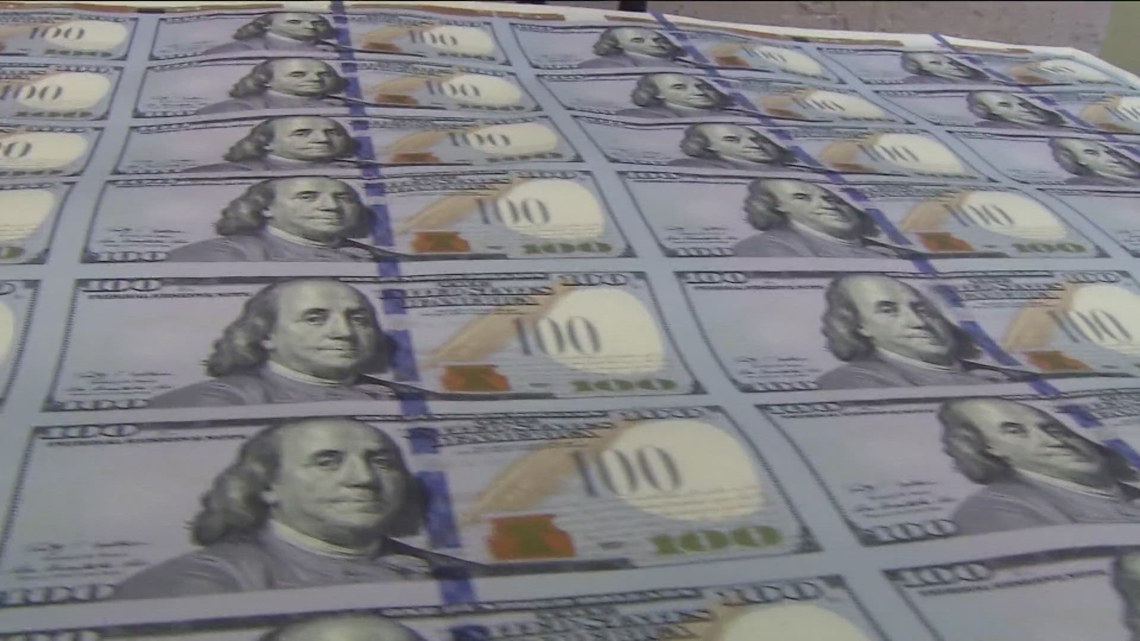CBS News
Will credit card rates fall with the next Fed rate cut?

Getty Images
In September the Federal Reserve slashed its benchmark rate for the first time in four years, and while any rate cut was a welcome move, the central bank dropped the Fed rate by a surprising 50 basis points rather than the widely expected 25 points. That decision quickly had far-reaching consequences, resulting in rates dropping on everything from mortgages to home equity loans.
But while borrowing money with a loan is now slightly cheaper thanks to the Fed’s rate decision, one area where borrowers could use some extra help currently is credit card debt. After all, credit card debt issues are compounding nationwide, with the average cardholder currently carrying approximately $8,000 in credit card debt and the average credit card interest rate now hovering near 23% — a record high.
Luckily, the Fed is widely expected to continue to cut rates at its next two meetings in November and December. So, many cardholders are hoping that it could help push down credit card rates to a manageable point. Will the next Fed rate cut actually lead to lower credit card rates, though?
Take steps to get rid of your credit card debt now.
Will credit card rates fall with the next Fed rate cut?
While cardholders may be holding out hope that the next Fed rate cut will ease the high-rate credit card environment, the reality is that the chances of that happening are slim. That’s due, in large part, to the fact that the Federal Reserve’s interest rate decisions can influence many aspects of borrowing and lending, but when it comes to credit cards, the relationship isn’t direct.
Unlike other types of borrowing, credit card interest rates aren’t as heavily influenced by the Fed rate decisions. Credit card rates are tied to the prime rate, which is impacted by the federal funds rate, but the big difference between loan rates and card rates is that credit card issuers have a lot of control over when and by how much they adjust their rates.
Historically, credit card companies have been quick to raise interest rates when the Fed increases the federal funds rate, but they have been slower to lower rates when the Fed makes cuts. This is partly due to credit card issuers wanting to maintain their profit margins, especially in a high-risk lending environment.
Credit card rates have also been on an upward climb over the last several years, and rarely is there a significant dip to the average credit card rate. Card rates have primarily increased instead, and it’s unlikely that another Fed rate could would have a major impact on that trend.
The upcoming Fed rate cut isn’t expected to be drastic, either, with analysts expecting a 25-basis-point cut to occur next. So, even if there is a credit card rate reduction as a result, the effect would almost certainly be modest — and would probably not make a meaningful difference. As a result, waiting for a Fed rate cut may not be the most effective strategy if you’re hoping to significantly reduce your debt load.
Start the debt relief process today.
How to lower your credit card interest rate now
Rather than waiting for credit card rates to fall in response to the next Fed rate cut, there are a few strategies you may be able to use to help lower your credit card interest rates now:
Negotiate with your card issuer
One of the most straightforward approaches is to contact your credit card issuer directly and request a lower interest rate. If you have a strong payment history and a good credit score, many issuers may be willing to offer a lower rate as a way to retain you as a customer. It’s always worth asking, as even a small reduction in your interest rate could save you a significant amount of money over time.
Transfer your balances
A balance transfer can be an effective way to reduce or eliminate your interest charges for a set period, as these cards offer low or 0% promotional APRs, allowing you to move your balance from a high-interest card to one with low or no interest for a promotional period (often 12 to 21 months). This gives you a window to pay down your debt more aggressively without accruing additional interest.
Take out a debt consolidation loan
By taking out a debt consolidation loan at a lower interest rate than your credit cards, you can pay off all of your high-interest balances at once and consolidate your debt into a single monthly payment. This strategy can simplify your finances and reduce the total amount of interest you pay over time, as debt consolidation loan rates are typically lower than credit card rates.
The bottom line
While the Federal Reserve’s next rate cut could bring some relief to certain types of borrowers, the impact on credit card interest rates is likely to be minimal. Rather than waiting for the Fed to lower rates, you may want to take proactive steps to reduce your interest burden through a balance transfer, debt consolidation or negotiating directly with your credit card issuers. By taking control of your debt now, you can work toward financial freedom without relying solely on external factors like the Fed’s rate cuts to make your debt more affordable.
CBS News
Beware the “street shark” and other common hurricane rumors and misinformation

As Florida and the Southeast recover from two major hurricanes, conspiracy theories and falsehoods have surged to levels that the head of the Federal Emergency Management Agency says are unprecedented. First responders, local officials and nonprofit organizations in the storm zones have had to dedicate time and resources to debunking false claims.
Officials say these falsehoods have real-world consequences, including preventing victims from evacuating or seeking help, distracting from recovery efforts and making the job of aid workers harder.
And while the scale of misinformation following Helene and Milton took some by surprise, the claims themselves follow a familiar pattern. Similar misinformation has followed other hurricanes and natural disasters, including exaggerated crime reports, fake or misleading visuals and outright scams. Researchers say understanding the misinformation is crucial to mitigating its spread and minimizing its impact.
Here is a look at some of the recurring themes to watch out for:
Unverified crime scares
In the aftermath of Helene, rumors spread online that people were slashing tires of trucks transporting aid to storm victims, a claim that local police said is not true.
Unverified crimes reports have followed storms for decades. After Hurricane Katrina devastated parts of Louisiana in 2005, officials later said claims of looting, murder, and rape, which were repeated by some news media and officials, were either exaggerated or false.
At one point, the Mayor of New Orleans reported multiple murders at the Louisiana Superdome, where thousands sheltered. The National Guard later said there were no homicides at the stadium.
A 2018 report by the Department of Homeland Security found that false claims often spread after disasters because verified information is slow to emerge, fuelling rumor and speculation.
Conspiracies
Jennie King, director of Climate Disinformation Research and Policy at the Institute for Strategic Dialogue, said conspiracies blaming the government for hurricanes have also become routine. Researchers at the institute found this claim and others debunked by FEMA generated more than 160 million views online after Helene.
“If it is producing a visceral emotion, negative or positive, that should cause you to pause for breath,” King said. “Do a little bit of wider reading. And if you do find out that those claims are false or unsubstantiated, don’t give them additional oxygen.”
Fake or misleading photos or videos
Edited or misleading videos and images have become a regular feature of major weather events. As Hurricane Dorian approached Florida in 2019, old images circulated online that pushed false claims of looting.
After Sandy hit New York and New Jersey in 2013, researchers identified over 10,000 unique posts on Twitter, now called X, that contained fake images.
One of these images was the now-famous “street shark” — an edited image of a shark swimming along a highway — which has reappeared during multiple hurricanes since at least 2011.
Fact checkers also regularly debunk images and videos of landmarks and transportation hubs submerged in water, which can mislead the public during natural disasters.
A digitally altered image of planes under flood waters, created by an artist in an effort to warn about the potential impact of climate change, was falsely described as showing the effects of hurricanes in 2017 and 2018.
And after Hurricane Milton hit Florida, AI-generated images appearing to show flooding at Disney World spread online on multiple platforms.
AI tools have made it easier for people to publish misleading or completely fabricated visuals, according to Anupam Joshi, who co-authored a study on misleading visuals after Hurricane Sandy.
“You need to take everything you see online with a very healthy grain of salt,” said Joshi, the director of the University of Maryland, Baltimore County Cybersecurity Institute.
Scams
Scammers often target victims of hurricanes and those wishing to help them. After Hurricane Katrina, scammers impersonated charities including the Red Cross, which was one of the reasons the U.S. Department of Justice established the National Center for Disaster Fraud.
Jun Zhuang, a researcher who studied misinformation online following Hurricanes Harvey and Irma, told CBS News that scammers solicit money from victims through fraudulent links.
“‘Hey, if you register to this link, you will get $200.’ Or the other way around, ‘Hey, please donate through this link,’ but you never know where your money is going to,” said Zhuang.
Historically, bad actors also target storm victims with offers of assistance. After Hurricane Sandy, fake “contractors” claimed that FEMA would reimburse survivors for damage assessments and rapid repairs to their homes. One of these scammers defrauded 30 people of about $1.9 million.
To avoid falling victim to scams, FEMA has advised people to be wary of unsolicited messages and to verify charities before donating.
CBS News
Boeing says it’s cutting 10% of its workforce, or about 17,000 employees

Boeing on Friday said it’s cutting 10% of its workforce, or about 17,000 employees.
In a in a memo Friday, CEO Kelly Ortberg announced the layoffs, writing that the aerospace giant must make “tough decisions” to stay competitive. Ortberg added that the company is also delaying its program to develop the 777X airplane and halting production of the 767 aircraft after it delivers the remaining 767 planes that have been ordered by customers.
The layoffs and production changes come amid a labor dispute at Boeing, with 33,000 machinists going on strike last month after failing to agree on a contract. The aerospace giant’s finances and reputation have also taken a hit this year due to manufacturing problems and multiple federal investigations, following a mid-air panel blowout in January.
“Our business is in a difficult position, and it is hard to overstate the challenges we face together,” said Ortberg in the memo. “Beyond navigating our current environment, restoring our company requires tough decisions and we will have to make structural changes to ensure we can stay competitive and deliver for our customers over the long term.”
Ortberg, the former head of aerospace company Rockwell Collins, joined Boeing as CEO in August, replacing outgoing CEO Dave Calhoun in the wake of increased regulatory scrutiny sparked by production problems at the storied company.
In his Friday memo, Ortberg said the layoffs will include executives, managers and employees, and take place within the “coming months.”
CBS News
Trump campaign requested use of military aircraft for final stage of campaign

Washington — Former President Donald Trump’s campaign requested military assets to enhance his security in the final weeks of the campaign in the wake of threats to his life, two sources familiar with the matter told CBS News.
In emails to the White House and the Secret Service late last week, the Trump campaign requested that a military aircraft be used to transport the former president before the election, according to the sources. The request also included expanded flight restrictions over Trump’s residences and campaign rallies, as well as the use of ballistic glass — a security measure the former president is already receiving.
The Washington Post first reported the requests Friday.
The development follows two assassination attempts against Trump since July. He was also the target of an alleged murder-for-hire plot involving a Pakistani national with ties to Iran. The country holds the former president and his administration officials responsible for a drone strike that killed Iranian Maj. Gen. Qasem Soleimani in 2020.
President Biden seemed receptive to the enhanced campaign security measures on Friday, telling reporters he “told the department to give him every, every single thing he needs.”
“As long as he doesn’t ask for F-15s,” Mr. Biden said at the White House.
He said the Republican presidential nominee should be treated as if “he were a sitting president.”
“If it fits within that category, that’s fine,” he added. “But if it doesn’t, he shouldn’t.”
The enhanced security is a break from precedent. No presidential nominee or former president in recent history has been transported by military plane before an election.
After the second assassination attempt against Trump, Mr. Biden signed a bipartisan bill that bolsters the Secret Service protection for major presidential and vice presidential candidates. The bill requires Secret Service to apply the same standards in determining the number of agents needed to protect the president, vice president and the major candidates for those offices.
In a statement to CBS News, Secret Service spokesperson Anthony Guglielmi said Trump “is receiving the highest levels of protection.”
“Assistance from the Department of Defense is regularly provided for the former President’s protection, to include explosive ordnance disposal, canine units, and airlift transportation,” he said. “Other enhancements the Secret Service has is providing includes Temporary Flight Restrictions (TFRs) over the former President’s residence and when he travels. Additionally, the former President is receiving the highest level of technical security assets which include unmanned aerial vehicles, counter unmanned aerial surveillance systems, ballistics and other advanced technology systems.”
Guglielmi said the Secret Service will “continue to adjust and enhance its protective posture as needed to mitigate evolving threats.”
contributed to this report.





